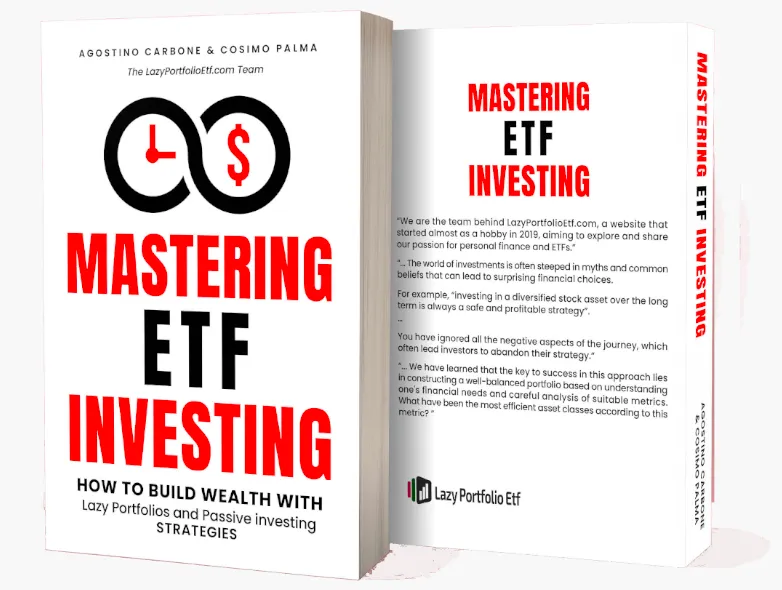When holding the SPDR Gold Trust (GLD) to EUR ETF, how long should you stay invested to have high probability to achieve a positive return?
Over the selected period (~72 years), the longest duration with a negative return was 313 months (from October 1980 to October 2006).
This indicates that, within the same timeframe, any rolling period of 314 months or more has consistently resulted in a positive return.
Understanding this metric is crucial as it highlights the importance of a safe investment horizon. Knowing the minimum duration required to likely see positive returns helps investors set realistic expectations and reinforces the strategy of staying invested through market cycles. This approach can mitigate the emotional reactions to short-term market fluctuations and enhance the likelihood of achieving financial goals.
SPDR Gold Trust (GLD) to EUR ETF: Historical Returns
Previous vs subsequent Returns
Is there a correlation between past and future returns over all 10-year rolling periods?
The following chart illustrates the relationship between past returns (x-axis) and subsequent returns (y-axis).
Data points are aggregated to show occurrences, and you can zoom in by clicking or drawing over the desired area.
Loading data
Please wait
Loading data
Please wait
As of Jun 30, 2025, the annualized return of the previous 10 years has been 9.90%.
Rolling Returns
A rolling return is a measure of investment performance that calculates the return of an investment over a set period of time, with the starting date rolling forward. This approach can provide a more accurate representation of the investment's historical performance and helps investors to evaluate the investment's consistency over time.
Loading data
Please wait
Loading data
Please wait
Loading data
Please wait
Loading data
Please wait
Loading data
Please wait
Loading data
Please wait
Loading data
Please wait
Loading data
Please wait
Loading data
Please wait
Loading data
Please wait
Loading data
Please wait
Loading data
Please wait
Rolling Period Analysis
By selecting the 'Rolling Period', the chart and data will update. To study a different date range, change the simulation settings.
Loading data
Please wait
Loading data
Please wait
| Worst | Median | Best | Negative Periods |
|---|---|---|---|
|
-31.20%
Jan 2013 - Dec 2013 |
+2.70% |
+161.70%
Feb 1979 - Jan 1980 |
38.85%
331 out of 852 |
|
-33.37%
Sep 1975 - Aug 1976 |
+0.02% |
+149.45%
Feb 1979 - Jan 1980 |
49.88%
425 out of 852 |
|
-17.06%
Feb 2012 - Jan 2014 |
+2.73% |
+80.47%
Apr 1972 - Mar 1974 |
33.57%
282 out of 840 |
|
-20.91%
Sep 1974 - Aug 1976 |
+0.70% |
+70.33%
Feb 1978 - Jan 1980 |
47.38%
398 out of 840 |
|
-11.71%
Aug 1987 - Jul 1990 |
+2.89% |
+55.78%
Feb 1977 - Jan 1980 |
29.83%
247 out of 828 |
|
-14.84%
Sep 1989 - Aug 1992 |
+0.19% |
+50.37%
Feb 1977 - Jan 1980 |
48.55%
402 out of 828 |
|
-11.64%
Sep 1988 - Aug 1992 |
+3.06% |
+47.04%
Sep 1976 - Aug 1980 |
25.74%
210 out of 816 |
|
-14.74%
Sep 1988 - Aug 1992 |
+0.74% |
+41.32%
Sep 1976 - Aug 1980 |
44.24%
361 out of 816 |
|
-9.94%
Sep 1987 - Aug 1992 |
+3.06% |
+34.58%
Sep 1976 - Aug 1981 |
25.50%
205 out of 804 |
|
-12.70%
Sep 1987 - Aug 1992 |
+1.00% |
+28.74%
Sep 1976 - Aug 1981 |
41.92%
337 out of 804 |
|
-8.00%
Feb 1985 - Jan 1991 |
+3.16% |
+28.59%
Sep 1976 - Aug 1982 |
25.13%
199 out of 792 |
|
-10.34%
Oct 1986 - Sep 1992 |
+0.99% |
+22.92%
Sep 1976 - Aug 1982 |
44.70%
354 out of 792 |
|
-8.06%
Sep 1985 - Aug 1992 |
+3.10% |
+32.49%
Feb 1973 - Jan 1980 |
25.77%
201 out of 780 |
|
-10.12%
Sep 1985 - Aug 1992 |
+0.74% |
+26.46%
Feb 1973 - Jan 1980 |
45.90%
358 out of 780 |
|
-8.34%
Feb 1983 - Jan 1991 |
+3.54% |
+33.41%
Feb 1972 - Jan 1980 |
22.14%
170 out of 768 |
|
-10.05%
Feb 1983 - Jan 1991 |
+1.76% |
+27.11%
Feb 1972 - Jan 1980 |
45.57%
350 out of 768 |
|
-7.89%
Sep 1983 - Aug 1992 |
+4.99% |
+31.01%
Feb 1971 - Jan 1980 |
19.71%
149 out of 756 |
|
-9.88%
Sep 1983 - Aug 1992 |
+2.91% |
+24.75%
Feb 1971 - Jan 1980 |
42.06%
318 out of 756 |
|
-6.38%
Feb 1983 - Jan 1993 |
+5.23% |
+28.63%
Oct 1970 - Sep 1980 |
19.49%
145 out of 744 |
|
-8.45%
Feb 1983 - Jan 1993 |
+3.23% |
+22.44%
Feb 1970 - Jan 1980 |
39.11%
291 out of 744 |
|
-5.15%
Sep 1981 - Aug 1992 |
+5.88% |
+25.70%
Dec 1969 - Nov 1980 |
18.03%
132 out of 732 |
|
-7.51%
Sep 1981 - Aug 1992 |
+3.74% |
+19.69%
Dec 1969 - Nov 1980 |
36.75%
269 out of 732 |
|
-5.18%
Sep 1980 - Aug 1992 |
+6.25% |
+24.03%
Feb 1971 - Jan 1983 |
17.08%
123 out of 720 |
|
-7.84%
Sep 1980 - Aug 1992 |
+3.86% |
+18.02%
Feb 1968 - Jan 1980 |
34.03%
245 out of 720 |
|
-4.24%
Sep 1985 - Aug 1998 |
+6.57% |
+22.69%
Feb 1970 - Jan 1983 |
17.51%
124 out of 708 |
|
-6.63%
Feb 1980 - Jan 1993 |
+4.06% |
+16.77%
Feb 1970 - Jan 1983 |
31.21%
221 out of 708 |
|
-4.44%
Oct 1984 - Sep 1998 |
+6.91% |
+20.08%
Dec 1969 - Nov 1983 |
17.39%
121 out of 696 |
|
-6.54%
Oct 1984 - Sep 1998 |
+4.26% |
+15.15%
Oct 1966 - Sep 1980 |
29.60%
206 out of 696 |
|
-4.65%
Sep 1983 - Aug 1998 |
+7.33% |
+19.44%
Feb 1968 - Jan 1983 |
17.84%
122 out of 684 |
|
-6.73%
Sep 1983 - Aug 1998 |
+4.58% |
+14.10%
Feb 1968 - Jan 1983 |
26.90%
184 out of 684 |
|
-4.53%
Feb 1983 - Jan 1999 |
+7.47% |
+18.16%
Feb 1967 - Jan 1983 |
16.96%
114 out of 672 |
|
-6.56%
Feb 1983 - Jan 1999 |
+4.73% |
+13.10%
Feb 1967 - Jan 1983 |
24.70%
166 out of 672 |
|
-3.41%
Feb 1983 - Jan 2000 |
+7.22% |
+17.04%
Feb 1966 - Jan 1983 |
16.06%
106 out of 660 |
|
-5.84%
Dec 1980 - Nov 1997 |
+4.60% |
+12.14%
Feb 1966 - Jan 1983 |
23.33%
154 out of 660 |
|
-3.48%
Oct 1980 - Sep 1998 |
+7.22% |
+16.02%
Feb 1965 - Jan 1983 |
14.97%
97 out of 648 |
|
-5.99%
Oct 1980 - Sep 1998 |
+4.65% |
+11.18%
Feb 1965 - Jan 1983 |
22.07%
143 out of 648 |
|
-3.19%
Sep 1980 - Aug 1999 |
+7.14% |
+15.14%
Feb 1964 - Jan 1983 |
13.21%
84 out of 636 |
|
-5.64%
Sep 1980 - Aug 1999 |
+4.50% |
+10.47%
Feb 1964 - Jan 1983 |
19.18%
122 out of 636 |
|
-2.28%
Jun 1983 - May 2003 |
+6.94% |
+14.34%
Feb 1963 - Jan 1983 |
11.38%
71 out of 624 |
|
-4.70%
Feb 1980 - Jan 2000 |
+4.34% |
+9.79%
Feb 1963 - Jan 1983 |
19.55%
122 out of 624 |
|
-1.35%
Feb 1980 - Jan 2005 |
+6.39% |
+11.44%
Feb 1958 - Jan 1983 |
2.30%
13 out of 564 |
|
-3.80%
Feb 1980 - Jan 2005 |
+4.06% |
+7.57%
Oct 1955 - Sep 1980 |
14.89%
84 out of 564 |
|
+1.75%
Feb 1980 - Jan 2010 |
+5.94% |
+9.39%
Sep 1953 - Aug 1983 |
0.00%
0 out of 504 |
|
-0.68%
Feb 1980 - Jan 2010 |
+3.29% |
+5.78%
Aug 1953 - Jul 1983 |
2.38%
12 out of 504 |
SPDR Gold Trust (GLD) to EUR ETF: Historical Returns



